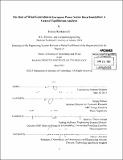| dc.contributor.advisor | Sergey Paltsev and Ignacio J. Peréz-Arriaga. | en_US |
| dc.contributor.author | Karkatsouli, Ioanna | en_US |
| dc.contributor.other | Massachusetts Institute of Technology. Engineering Systems Division. | en_US |
| dc.coverage.spatial | e------ | en_US |
| dc.date.accessioned | 2013-09-24T19:44:22Z | |
| dc.date.available | 2013-09-24T19:44:22Z | |
| dc.date.copyright | 2013 | en_US |
| dc.date.issued | 2013 | en_US |
| dc.identifier.uri | http://hdl.handle.net/1721.1/81123 | |
| dc.description | Thesis (S.M. in Technology and Policy)--Massachusetts Institute of Technology, Engineering Systems Division, 2013. | en_US |
| dc.description | Cataloged from PDF version of thesis. | en_US |
| dc.description | Includes bibliographical references (p. 89-93). | en_US |
| dc.description.abstract | Wind generation has been growing fast, with onshore wind having a 27% average annual growth rate over the past decade. Motivated by this growth, a comprehensive analysis of both the economic and engineering implications of a large wind penetration in power systems was conducted. In order to understand and capture the unique characteristics of wind generation different tools and methods were combined. First, an analysis of hourly wind and load profiles was completed for individual European countries and for the whole European region. Then, a detailed electricity model was used in order to capture the effects of a large wind penetration (up to 60% of total demand) on the power system. Finally, this information was integrated in a computable general equilibrium (CGE) model, the MIT EPPA model - a tool for analyzing the economy-wide implications of energy and climate policies. Based on the bottom-up modeling results, a new methodology for capturing wind intermittency in EPPA, through modeling system flexibility requirements at large wind penetration levels, was proposed. As a case study, a 40% and an 80% GHG emissions reduction scenarios by 2050 (relative to 1990 levels) were modeled for Europe. The analysis illustrates that, in order to mitigate wind intermittency, particularly for large wind penetration levels, a system needs to have enough flexible capacity installed - traditionally provided by gas or hydro technologies. However, it is shown that for a significant emissions reduction scenario (80% GHG reduction in Europe by 2050), providing this flexibility from the generation side might be challenging as low-cost, low-carbon, flexible, dispatchable technological options might be limited. This might impose a constraint on the total electricity use and on the growth of wind penetration. Thus, the importance of considering other options for providing flexibility in the system, such as storage, demand response or interconnections is displayed. In particular, the wind and load profile analysis indicates a high value of interconnecting wind farms in the European region. | en_US |
| dc.description.statementofresponsibility | by Ioanna Karkatsouli. | en_US |
| dc.format.extent | 93 p. | en_US |
| dc.language.iso | eng | en_US |
| dc.publisher | Massachusetts Institute of Technology | en_US |
| dc.rights | M.I.T. theses are protected by
copyright. They may be viewed from this source for any purpose, but
reproduction or distribution in any format is prohibited without written
permission. See provided URL for inquiries about permission. | en_US |
| dc.rights.uri | http://dspace.mit.edu/handle/1721.1/7582 | en_US |
| dc.subject | Engineering Systems Division. | en_US |
| dc.title | The role of wind generation in European power sector decarbonization : a general equilibrium analysis | en_US |
| dc.type | Thesis | en_US |
| dc.description.degree | S.M.in Technology and Policy | en_US |
| dc.contributor.department | Massachusetts Institute of Technology. Engineering Systems Division | |
| dc.identifier.oclc | 858280278 | en_US |
